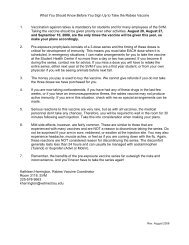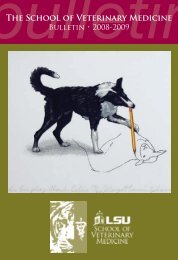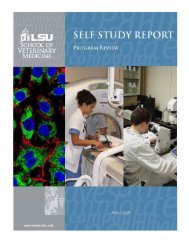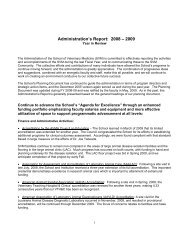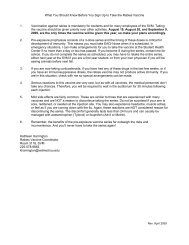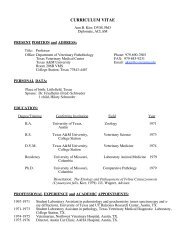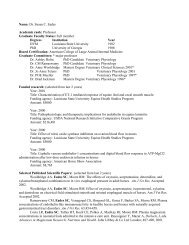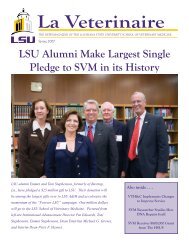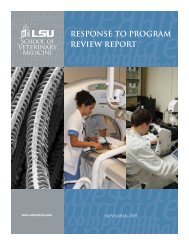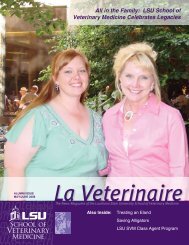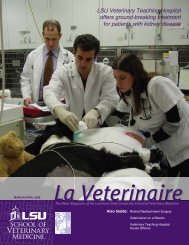2006 merck/merial - School of Veterinary Medicine - Louisiana State ...
2006 merck/merial - School of Veterinary Medicine - Louisiana State ...
2006 merck/merial - School of Veterinary Medicine - Louisiana State ...
Create successful ePaper yourself
Turn your PDF publications into a flip-book with our unique Google optimized e-Paper software.
Novel therapy for humoral hypercalcemia <strong>of</strong> malignancy in adult T-cell leukemiaEffects <strong>of</strong> proteasome inhibitor and bisphosphonate on tumor growth and bone formationin vivo and in vitroSherry Shu, Murali VP Nadella, Wessel Dirksen, and Thomas J RosolDepartment <strong>of</strong> <strong>Veterinary</strong> Biosciences, The Ohio <strong>State</strong> University,1925 C<strong>of</strong>fey Road, Columbus, OH, USAAdult T-cell lymphoma/leukemia (ATLL) is an aggressive and <strong>of</strong>ten fatalmalignancy <strong>of</strong> CD4+ T-lymphocytes caused by infection with a complex retrovirus, human T-celllymphotropic virus type 1 (HTLV-1). More than 80% <strong>of</strong> ATLL patients develop HHM resulting fromincreased osteoclastic bone resorption and renal reabsorption <strong>of</strong> calcium. Factors secreted by tumorscells that can contribute to HHM include, interleukin-1 (IL-1), IL-6, tumor necrosis factor-α (TNF-α),TNF-β, and parathyroid hormone-related protein (PTHrP). PTHrP has been shown to play an essentialrole in HHM and the expression <strong>of</strong> PTHrP and cytokines, including TNF-β, can be activated by NF-кB.Proteasome inhibitor, PS-341, is able to disrupt NF-кB in vitro and in vivo. In addition, bisphosphonates,such as zoledronic acid (Zol), have been used for treatment <strong>of</strong> tumor-induced hypercalcemia; however,little is known about the effects <strong>of</strong> these two drugs on tumor burden and hypercalcemia in ATLLpatients. Our goal is to establish an in vivo model to evaluate the effects <strong>of</strong> NF-кB and osteoclastinhibition on the development <strong>of</strong> T-cell malignancy and HHM. To monitor tumor burden in vivo bynoninvasive bioluminescent imaging (BLI), ATLL cells derived from a patient (RV-ATL cells) werestably transduced with luciferase reporter gene (luc) in a lentivirus construct in vitro. Twenty millioncells (RV-ATL-luc) were injected into NOD/SCID mice and BLI was performed every week. Signalwas detected as early as week one and continued to increase until sacrifice (Figure 1). The ex vivo BLIfor each organ indicated that tumor cells infiltrated mainly the mesenteric lymph nodes and spleen(Figure 2). Solid tumors formed at the site <strong>of</strong> injection have also been observed. Histological evaluationconfirmed the ex vivo findings. To examine the in vitro effects <strong>of</strong> PS-341 and Zol on proliferation, cellviability, and apoptosis in ATLL cells, MTT, trypan blue exclusion and TUNEL assays were performed,respectively. PS-341 significantly inhibited proliferation (IC50≈10 nM), decreased viability (50%reduction at 25 nM), and induced apoptosis (43% at 20 nM) in RV-ATL cells; however, the effects <strong>of</strong>Zol on proliferation, cell viability and apoptosis were not significant, as expected (Figure 3). We havealso found that PS-341 inhibited PTHrP expression by 80% in RV-ATL cells at 10 nM using real-timeRT-PCR (Figure 4). For the in vivo assay, 3x107 RV-ATL-luc cells were injected into 5-week-oldNOD/SCID mice. Mice were treated twice a week with vehicle alone, PS-341 alone, Zol alone, andcombined PS-341 and Zol. BLI was performed at weeks 4 and 5. The signals in PS-341 alone and thecombined groups were lower than the vehicle control group and Zol alone group (Figure 5). Thetrabecular bone density in Zol alone group was higher than the vehicle group, which indicated theinhibition <strong>of</strong> osteoclastic activity (Figure 6). Our results indicate that a combination <strong>of</strong> PS-341 and Zolwas an effective treatment for ATLL.34



